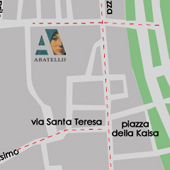Via Torremuzza
Next to Abatellis Palace, raises S. Mary of the Pieta’s Church, build by the Benedectine Sisters in 1678 on a plan by Giacomo Amato, which in the outstanding front which two orders refers to coeval examples of the Roman architecture. Inside, stuccoes by Giacomo Serpotta, frescoes by Guglielmo Borremans (underchoir) and by Antonio grano (vult); on the third altar there is a painting by Vincenzo da Pavia with the “The Mercy of the Madonna contemplating Jesus” from which the name of the church.
Always on a plan by Giacomo Amato, during the XVII century were built the Novitiate of the Cruciferouses and St. Mattia’s Church, with an octagonal plan covered by a great dome, and St. Teresa’s Church at the Kalsa, whose two orders prospect dominates the square before. At its inside, at a single nave with deep lateral chapels, stucco decorations and precious XVIII century paintings.
At the back of the Church, along "via dello Spasimo" rises the Oratory of the Company of the Holy Crucified raiser, called “the White men's” (composed of noblemen who took to right death the condemnend to the capital punishment), and, a bit furter, on the southern front of the street, the late-gothic church of "Santa Maria dello Spasimo".
Via Torremuzza ends on the east into the perpendicular Via Lincoln, whose eastern front in mostly occupied by Villa Giulia. The wide public garden realized on a plan by Architect Niccolň Palma in 1777. The Garden is divided into rectilinear avenues developing around a round square surrounded by the four music pavillons designed by Damiani Almeyda.
The contiguous Botanic Garden, founded in 1779 is developed in Gymnasium, Calidarium and Tepidarium planned by the french Architect Lčon Dufourny. The garden is developed around the historical nucleus, with plants divided on the base of precise scientific criteria.
On the opposite side of Via Torremuzza, you can see Butera Palace, residence of the Branciforte, princes of Butera. The main halls were frescoed during the XVIII century by Gioacchino Martorana.
The opposite side of the Palace faces the “Mura delle Cattive”, from which you can enjoy a wondeerful sight of the sea.
Reference text:
Chirco Adriana, Palermo La città ritrovata: venti itinerari entro
le mura, Palermo1997
